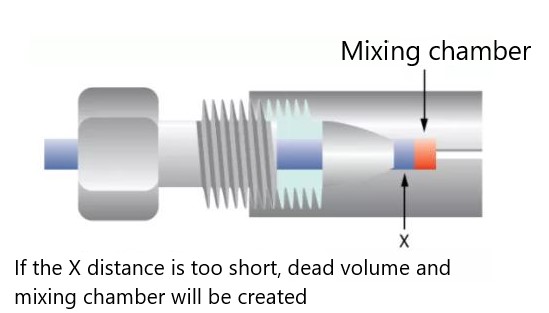All of you guys have heard of dead volume. The larger the dead volume is, the more room for sample diffusion, the easier the chromatographic summit will be to broaden, and the worse the peak shape will be. So how do you define the dead volume, and how to calculate the size of the dead volume? Here uHPLCs will give you a small partner to do an introduction.
Dead volume definition

Dead volume, in a narrow sense, refers to the volume of space in the column that is not occupied by the stationary phase, i.e., the volume of the mobile phase inside the column. Dead volume, in a broad sense, is the volume of the section from the injection position (inlet port) to the detection position (detector flow cell) (PS: excluding the packing volume in the hplc column), which is unchanged (dead) once the column is connected (dead volume).
Dead volume calculation
For HPLC, how to calculate the dead volume?
Dead volume (V0) – the space from the injector inlet to the mobile detector cell that is not occupied by the stationary phase. It consists of four parts:
- The volume of the inlet to the column pipeline
- The gap between the stationary phase particles in the column (occupied by the mobile phase, Vm)
- The volume of the column exit pipeline
- The volume of the detector flow cell
Only Vm is involved in the chromatographic equilibrium process, and the other 3 parts only play the role of peak expansion. To prevent peak expansion, the volume of these three parts should be minimized.
Dead time (dead time, t0) – not retained components of the retention time. It is time for the mobile phase (solvent) to pass through the column.
Measurement of the dead system volume usually requires experimental measurement, the common method is through a needle, and the stationary column phase does not play any role in the special solution. You will get a peak, which can be measured by slow time (t0), which is the actual measurement of t0 results.
Then the dead volume of the system is obtained by calculation:
Dead volume (V0) = dead time t0 × flow rate F of the mobile phase.
Dead volume reduction
In the process of our use or maintenance, if it involves the replacement of piping and other accessories, we should choose hplc accessories with the same specifications as the original to ensure that the dead volume is the same as the original to avoid the increase of dead volume and bring about the spreading of the peak shape. When installing the column, make sure that the pipeline connectors are well matched (pay special attention to the use of peek tubing connectors and the connection between the pipeline and the column) to avoid the formation of joint cavities (as shown below).

Post time: Nov-26-2022






